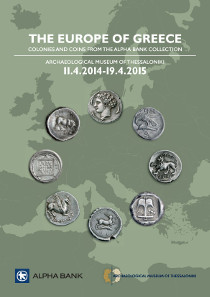22. Mai 2014 – The Archaeological Museum of Thessaloniki and the Alpha Bank Numismatic Collection collaborate once again and have organised the exhibition entitled ‘The Europe of Greece: Colonies and Coins from the Alpha Bank Collection’ at two of the Museum’s Temporary Exhibitions Galleries.
The Exhibition presents the Greek Colonisation in Europe as well as the dissemination and the use of coins which constitute the principal medium of transactions. The Greek colonies founded during the Second Colonisation, in modern Spain, France, Italy, Albania, Ukraine, Romania and Bulgaria shaped the culture of Europe and promoted the use of coins which, in Mainland Greece, had already been used since the beginning of the 6th century BC.
The Exhibition will showcase 121 coins from Greek colonies, of which 116 belong to the Alpha Bank Numismatic Collection, 3 to the Numismatic Museum of Athens and 2 to a Private Collection.
The coins are accompanied by 61 unique artifacts, produced in workshops of Greek colonies, in order to facilitate the understanding of the historical course and development of the colonies presented in the Exhibition. These artifacts come from the National Archaeological Museum, the Archaeological Museum of Thessaloniki, the Archaeological Museums of Delphi, Olympia, Eretria and Ioannina, as well as from the 3rd Ephorate of Prehistoric and Classical Antiquities (Athens).
The Exhibition also includes ancient artifacts from three Museums of Italy (Museo Archeologico Nazionale della Sibaritide, Museo Αrcheologico Νazionale della Siritide, Museo Archeologico di Giardini Naxos) and two Museums of Spain (Museu d’Arqueologia de Catalunya, Barcelona-Empúries), two countries where the colonising activity of the Greeks was intensive.
The Exhibition is structured in three units, as follows:
Colonisation: adventure and challenge, identity and nostos
The introductory unit outlines the role of the sea as a vital force of Hellenic civilisation, the main myths, the epics and the emblematic heroes invented on the basis of maritime adventures. It spotlights various facets of Colonisation, the historical, social and economic framework that secured the suitable conditions and, primarily, its correlation with the emergence of the Greek city-state.
New homelands from the Euxine Pontos to the Pillars of Heracles
This unit deals with the geographical spread of Colonisation to South Italy and Sicily, Southern France, Spain, the Illyrian Coasts and the Euxine Pontos. A total of 39 colonies are presented, the most representative of the regions. Each colony constitutes a separate microcosm and its own particular characteristics and coinage are determined. Special weight is attached to the dissemination of the Greek alphabet to the local populations, to the diffusion of coinage and new crops, such as the vine, as well as to the prevalence of Greek habits, such as the symposium, the cults and the theatre.
The Greeks and the Others
The last unit of the Exhibition is devoted to the relations that developed between the Greeks and the neighbouring peoples in the regions where colonies were founded. Through this coexistence influences were generated, new cultural traits were introduced and, therefore, cohabitation became possible, despite whatever differences. Special mention is made of the Greeks’ relations with the seafarers and potential rivals, the Phoenicians and the Celts of Western and Eastern Europe.
The Exhibition is accompanied by a fully illustrated catalogue-album in Greek and in English.
You can find more information on the exhibition on the websites of the Archaeological Museum of Thessaloniki …
… and of the Αlpha Bank Numismatic Collection.





